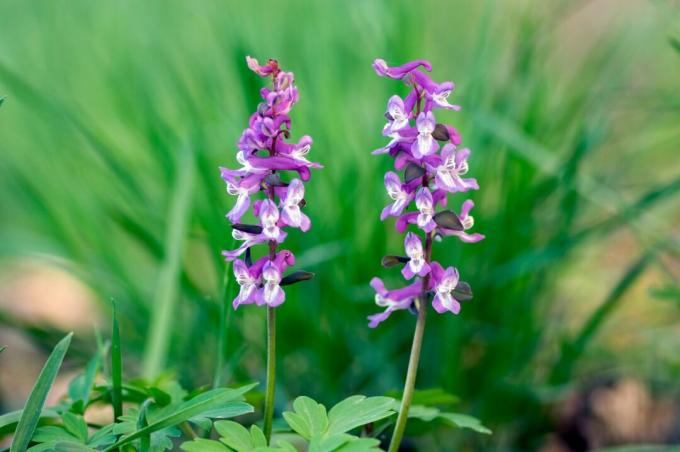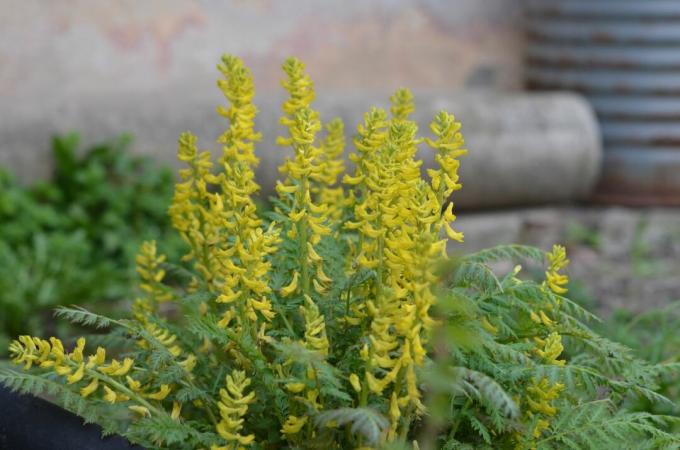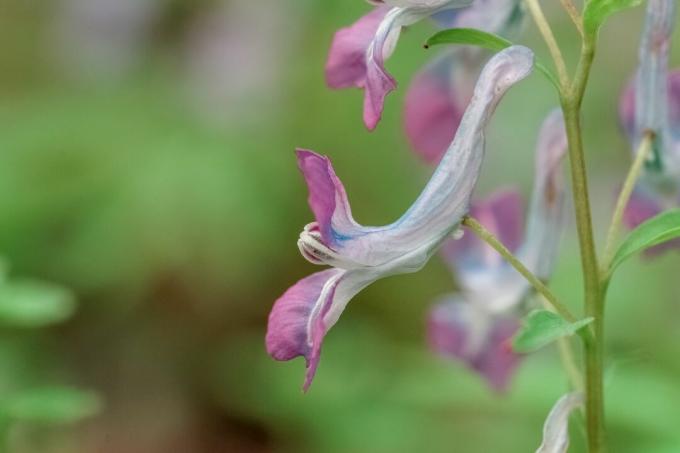The lark spur is a versatile plant genus, some of whose species also occur as wild plants in Germany. We'll show you how to care for the lark spur in the garden.

Species of the genus Lerchensporn (Corydalis) are quite robust, easy to care for and also thrive in shady locations. We show what you should consider when caring for it and introduce the most beautiful species and varieties.
contents
- Larkspur: flowering, origin and characteristics
- The most beautiful larkspur species and varieties
- Plant larkspur
- The most important maintenance measures
- Are lark spurs poisonous?
- Larkspur: Medicinal Effects and Uses
Larkspur: flowering, origin and characteristics
The lark spurs form a genus within the poppy family (Papaveraceae) and occur all over the northern hemisphere and partly in South Africa. The spur typical of the flowers gave the herbaceous plant its name. It is reminiscent of both the crested lark and the claw of the skylark. Some species of larkspur are native to Europe and grow naturally as wild perennials. Other varieties are specially bred for the garden. The genus has 300 to 400 species that have an enormous variety of colors. There are lark spurs in yellow, blue or white and many other variants. As a native wild plant, the larkspur is also a valuable insect pasture. Some species form tubers and appear as early as spring, while other species form rhizomes and still bear foliage later in the year. In addition, lark spurs can be either annual or perennial. Flowering time and growth habit vary from species to species. The lark spurs are often compound and lobed or pinnate.

The most beautiful larkspur species and varieties
There are not only numerous species of larkspur, but also varieties that enrich the garden with their flowers. We present the most beautiful species and varieties.
- Hollow Larkspur (Corydalis cava): The hollow lark spur is widespread in Germany and also occurs in nature. The name comes from the cavity inside the tuber. The deciduous hollow lark spur blooms in purple hues from March to May and grows clumps. It prefers a partially shady to shady location.

- Yellow Larkspur (Corydalis lutea): As the name suggests, the yellow lark spur also produces yellow flowers. It shows its flowers in summer between May and September. Due to its richly branched shoots, the yellow lark spur appears bushy. He prefers a lighter location that can even be sunny.

- Fern Larkspur (Corydalis cheilanthifolia): The name says it all for this species too. The leaves look very similar to the leaves of the ferns. The fern-lark spur shows its yellow flowers between April and June and retains its foliage even in winter, which then changes its color from green to brown.

- Blue Larkspur (Corydalis elata ‘Blue Summit’): The steel-blue flowers of the Blue Summit ’variety appear between May and July. The smell of the flowers is reminiscent of bitter almond. The blue lark spur likes a partially shaded or shady place, for example under a deciduous wood. It can be 30 to 40 cm high.

- Fingered larkspur (Corydalis solida "GP Baker"): The strong red flowers of the ‘GP Baker’ variety appear between March and May. The fingered larkspur occurs naturally in Germany, but it is much rarer to find than the hollow larkspur.

Plant larkspur
If you are planting a larkspur, you should first find out about the respective species. Since there are many different types and varieties, the requirements can vary. However, certain conditions are preferred by most species.
It is best to plant the larkspur in autumn between September and October. It does not matter whether it is a tuber or a young plant. The right location for the lark's spur is partially shaded - some species like it sunnier, others get by with less light. The soil should be fresh, well-drained, humus and rich in nutrients and be able to hold the water well in summer. For group planting, you should keep a distance of at least 10 cm, but better still 20 to 30 cm, between the plants. Before you put the plant in, you can work some compost soil into the soil to make it easier for the lark spur to start. After planting, the substrate is poured and a layer of mulch, for example made of leaves, is applied. This protects the plants from the cold in winter and from dehydration in summer.

If you want to plant the lark spur in the pot, the first thing to do is to put a drainage layer in the container. These can be potsherds or stones that ensure that the water can drain off properly. The lark spur does not like waterlogging, as this can lead to rotten roots. Then plant it in a humus rich, well drained substrate. For example, ours is suitable Plantura organic compost, which has a particularly high proportion of organic matter and provides the lark spur with important nutrients. It consists of natural raw materials and does not require any peat. The organic soil is not only good for plants and gardens, but also for the environment. You can also use the compost as a starting aid in the bed. Mix in a third of sand or broken expanded clay for better permeability.
The most important maintenance measures
The larkspur is a very easy plant for the garden. Regular watering is essential when caring for larkspurs so that plenty of flowers are formed and the plants remain healthy.
Garden plants, especially the larkspur in pots, should be watered regularly without waterlogging. In summer you can check the substrate every one or two days. It should always be slightly damp and should be poured with tap water as soon as the upper layer of soil feels dry. With potted plants, remove the excess water in the saucer.

Whether you want to cut the lark's spur depends on your ideas. After the flowering period, pods form. The seeds contained in it provide for new plants in the area for the next season. If you want to prevent or curb this self-sowing, cut off withered flowers as early as possible. This can also increase the flowering time. When all the foliage has withered in the fall, you can cut the plants just above the ground.
The larkspur does not need many nutrients. Nevertheless, you should occasionally provide it with the basic nutrients so that you can continue to enjoy its flowers. At the beginning of the growing season in early spring, you can work a slow release fertilizer into the soil once a year. Our granulate fertilizer, for example, is ideal Plantura organic flower fertilizer at. The nutrients are released slowly here and are therefore available over a long period of time. The nutrient composition promotes the growth of leaves, flowers and roots. If you keep the larkspur in the bucket, you can repot it occasionally. The fresh earth then also brings new nutrients with it.

Are lark spurs poisonous?
The lark's spur is poisonous, especially in the root or tuber area. However, the poisonous substances are also found in smaller quantities in the above-ground parts of the plants. Gastrointestinal complaints can occur after consumption.
Larkspur: Medicinal Effects and Uses
In the past, the lark's spur was said to have a healing effect, but today it is no longer used. Due to the calming effect of the substances it contains, the lark's spur was used for anesthesia and the tubers were used as food.
Also the Marigold (Calendula) is a valuable insect pasture. In our profile you can find out everything about the pretty daisy family.



